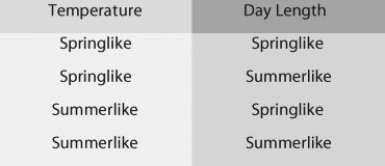
Figure 1.1
The following experiment is used for the corresponding question(s) .
A researcher discovered a species of moth that lays its eggs on oak trees.Eggs are laid at two distinct times of the year: early in spring when the oak trees are flowering and in midsummer when flowering is past.Caterpillars from eggs that hatch in spring feed on oak flowers and look like oak flowers.But caterpillars that hatch in summer feed on oak leaves and look like oak twigs.
How does the same population of moths produce such different-looking caterpillars on the same trees? To answer this question,the biologist caught many female moths from the same population and collected their eggs.He put at least one egg from each female into eight identical cups.The eggs hatched,and at least two larvae from each female were maintained in one of the four temperature and light conditions listed below.

Figure 1.1
In each of the four environments,one of the caterpillars was fed oak flowers,the other oak leaves.Thus,there were a total of eight treatment groups (4 environments × 2 diets) .
-Refer to Figure 1.1.In every case,caterpillars that feed on oak flowers look like oak flowers.In every case,caterpillars that were raised on oak leaves looked like twigs.These results support which of the following hypotheses?
A) The longer day lengths of summer trigger the development of twig-like caterpillars.
B) Differences in air pressure,due to elevation,trigger the development of different types of caterpillars.
C) Differences in diet trigger the development of different types of caterpillars.
D) The differences are genetic a female will produce all flowerlike caterpillars or all twig-like caterpillars.
Correct Answer:
Verified
Q16: Louis Pasteur's experiment had a good design
Q20: How does a scientific theory differ from
Q21: The best experimental design _.
A)includes a large
Q22: Agrobacterium is a type of bacteria that
Q23: Recall the caterpillar experiment,where caterpillars born in
Q24: A friend of yours calls to say
Q27: On an evolutionary tree,any group that includes
Q29: Current evolutionary data groups land plants with
Q30: Use the following information when answering the
Q30: Figure 1.1
The following experiment is used for
Unlock this Answer For Free Now!
View this answer and more for free by performing one of the following actions

Scan the QR code to install the App and get 2 free unlocks

Unlock quizzes for free by uploading documents